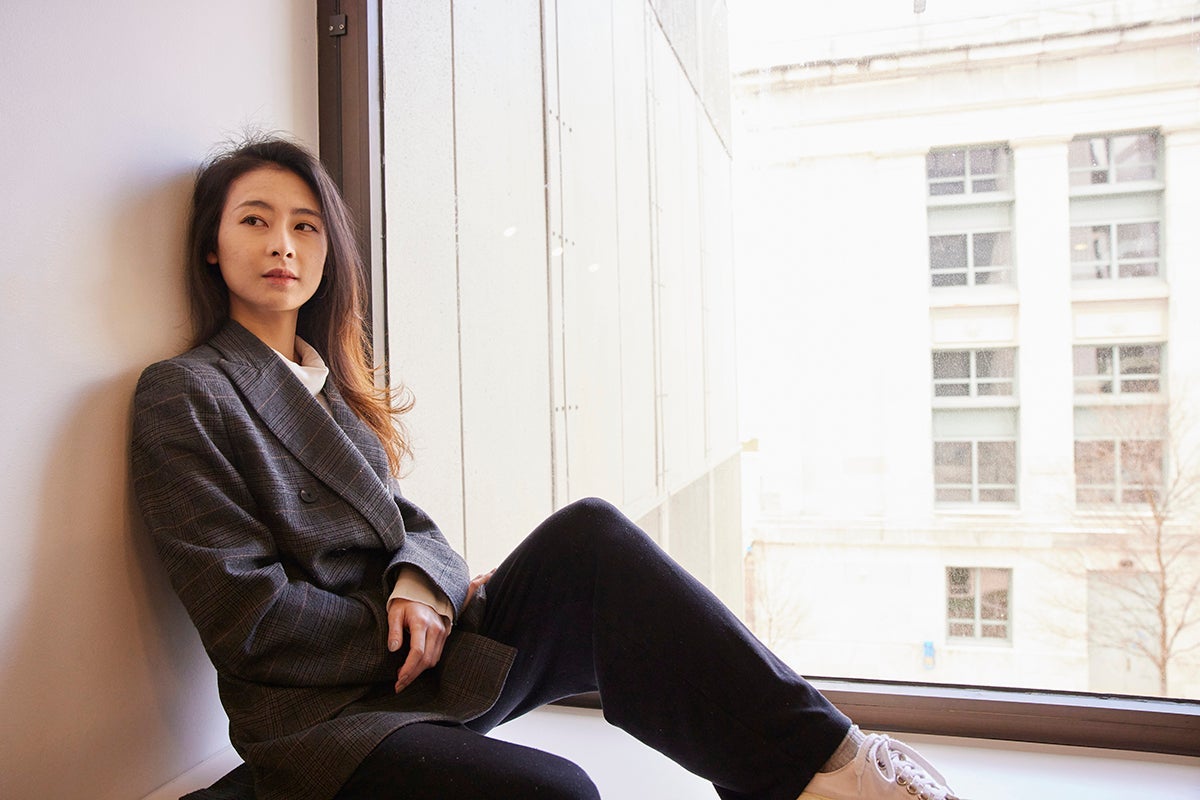How building design can improve people’s well-being

An unsettling pollution event in her hometown got Flora Jiaxuan Xu, SM ’23, thinking about the relationship between humans and the built environment
April 24, 2023 – Flora Jiaxuan Xu’s hometown of Harbin, in northern China, is known for an annual winter festival that features massive and breathtaking ice and snow sculptures, drawing millions of visitors from around the world. On October 22, 2013, Xu woke up to a white world. “At first I thought it was snow coming really early in October,” she said. “But later I realized it was heavy smog.”
The smog lasted for days. School was canceled for at least three days. People mostly stayed in their houses. Fine particulate air pollution (PM2.5) levels soared to 1,000 micrograms per cubic meter of air (μg/m3), far above the World Health Organization’s guideline, which states that 24-hour average exposures should not exceed 15 μg/m3. “You could literally smell the pungent odor of the smog. You could see the black dots scattered on your window,” Xu recalled.
That devastating event, seared into Xu’s memory, fueled her interest in environmental health and sustainability, leading her first to the University of California Berkeley to study sustainable environmental design and cognitive science, then to Harvard T.H. Chan School of Public Health where, as a master of science student, she has focused primarily on how the indoor built environment affects human well-being.
Along the way, Xu has taken courses in a wide range of areas, including architecture, urban planning, building design, law, psychology, sociology, computer science, toxicology, and occupational health. Her goal is to fully equip herself as she works to understand the relationship between humans and the environment, in order to contribute to a sustainable future.
Problem solving
After the extreme smog event in Harbin, Xu wanted to know why it happened and what could be done about it. She learned that the smog was the result of a convergence of factors: The nearby heating plant, fueled by coal, needed an equipment upgrade to meet an updated stringent emission limit, and local farmers were burning agricultural residue in open fields, a common occurrence but that year every farmer seemed to be burning the residue at the same time. Said Xu, “All of this together, combined with weather factors, decision-making procedures, and other issues created a lot of pollution.”
Xu was only a high school student, but she wanted to fix the problem, somehow. “My parents helped me reach out to one of the heating plant managers. Can you imagine? Here was this naïve high school student being really passionate about air pollution, saying that we need to make some changes, we need to act right now. The heating plant manager said to me, ‘We don’t have the money. There’s nothing I can do,’” she said. Xu also learned that some farmers’ focus wasn’t on the environment—instead, it was on making sure they had a good crop yield, and burning their agricultural residue was important because it provided them with fertilizer for the following year.
Learning curve
The Harbin smog event got Xu thinking about how the built environment affects people’s health, and about sustainability. Also interested in art—she’d been learning Chinese calligraphy and painting for many years—she settled on an undergraduate program at Berkeley in sustainable environmental design. After a couple of years she decided to do a double major in cognitive science. The combo gave her technical skills in how to build a sustainable building as well as an understanding of how people perceive the environment, and buildings in particular. In one of her projects at Berkeley, she looked at ways to use natural light in an art museum to both minimize energy use and improve visitors’ experiences.
Although Xu wasn’t originally focused on public health, she thought about it a lot more after the pandemic hit, which led her to Harvard Chan School in 2021. She has felt “super blessed” to have John Spengler, Akira Yamaguchi Professor of Environmental Health and Human Habitation, as her adviser. “The first time we met, I remember clearly that he told me, ‘Okay, Flora, we have enough problems. What we need now are solutions.’ His words gave me a really grand goal for the two years I have spent here at Harvard.”
Spengler encouraged Xu to take courses from across the University. One of her favorites was the Climate Solutions Living Lab at Harvard Law School, in which students from various schools work on solving a real-world challenge. Xu’s project involved examining a framework for evaluating hypothetical carbon abatement projects for buildings in the city of Boston. She worked alongside students from fields including public policy, urban planning, and business. The experience helped drive home the lesson that solving environmental problems isn’t just about focusing on health impacts. “It’s about money, it’s about politics, it’s about business—how the whole system works,” she said. “In addition, the course taught me how to work with people from different disciplines.”
Xu has also worked with Spengler on several research projects. One looked at a company in Bangkok, Thailand, evaluating employees’ productivity and well-being working from home versus working in their offices during the pandemic. Among the study’s findings: Whether employees were working at the office or remotely, they fared better, in terms of both job performance and satisfaction, when they had quieter workspaces and more natural light. Noted Spengler, “[Flora’s] analysis yields new insights about how the indoor environmental, managerial, and social aspects affect job satisfaction, and the ways that personal characteristics modify those factors. The company in Thailand, which values the well-being of its employees, will be guided by these findings as they set the new norms for working in a post-pandemic world.”
Xu has also conducted research with Harvard Chan School’s Healthy Buildings team, under the direction of Joseph Allen, associate professor of exposure assessment. In this capacity, she looked at the association between indoor lighting and sleep quality for participants working from home during the pandemic, considering their exposure both to daylight and to indoor lighting after dark. The goal of the study is to pinpoint healthy lighting behaviors in order to provide guidance on sleep issues for remote workers.
This semester, Xu took a class in environmental negotiation, at Spengler’s suggestion. “I’m learning a lot,” she said. “We have simulations where we discuss environmental topics while playing different roles, such as from the vantage point of a governor or representatives from the energy sector. We’re learning how to strategically manage your role in negotiations, how to use stories to move people to take actions, and how to build up power for effective leadership.” She added, “I have to admit, I’m actually an introvert, but this class has helped push me out of my comfort zone. In every class, we need to talk to somebody and take challenging positions to argue points. Now I feel like I can talk on and on and persuade people with strategic conversations.” The class, she said, has also taught her how to communicate numbers and facts from research into actionable discussions, “and how complicated and challenging climate conversations are in the real world.”
Solid ground
Spengler said it has been a pleasure being Xu’s adviser. “She is inquisitive, responsive, and always appreciative,” he said, adding, “Flora pursues a challenge with enthusiasm, whether it is a technical building science course at MIT or a leadership course at the Kennedy School.”
Next stop for Xu is a doctoral program in environmental health at Stanford University’s new School of Sustainability, where she plans to continue her focus on the sustainable built environment and people’s well-being, with the goal of driving behavioral and ideological changes. “I hope that sustainability is going to be a bigger topic in the future, and I think the doctoral program will help me build solid ground in having the ability and the scientific background to make responsible environmental recommendations,” she said.
She can see herself in any number of fields, eventually—such as academia, industry, or government—but whatever role she ends up in, she wants to focus on solutions, as Spengler advised her early on. She said, “Even if I can just help a small amount of people, a community or a group, that will be satisfying to me.”
Photos: Kent Dayton


